It’s 3 am. We’re suddenly awoken by the sound of something thundering towards our room. We sit bolt upright in bed, fumbling to the bedside light. Something large, very large, brushes against the outside canvas wall of our tent. Next, we hear snarling and roaring, it sounds very much like a lion or two runs past the room. We hold our breath, our ears straining to hear more, as we try to figure out what has just happened. We can hear more lion roaring noises, around the staff accommodation, a few hundred metres away. Twenty minutes later, still sitting up in bed, we hear a hyena passing nearby, followed a little later by some jackals bickering. Eventually, the noise dies down and the night descends into silence once more. I get out of bed, and with a torch in one hand, open the door and lookout. In the sand, right on our doorstep, I can see the tracks of a buffalo and some lion footprints too. It’s dark, and I’m frankly too nervous to step out the door, so retire to bed, trying to imagine what has gone on, under the cover of darkness.

The next morning the camp is abuzz with talk about what had happened the previous night. As we drink our early morning coffee, before heading out on a game drive, the cook and her assistant regale us with the tale of what had gone on in the staff compound during the night. After charging past our room, almost getting tangled in the tent’s guy ropes en route, a huge buffalo, with three lions, two male and one female, in hot pursuit, stumbled into the clearing between the staff houses. One male leaps onto the buffalo’s hindquarters, almost bringing it down. But then he spots the other male who, distracted by the female, is clearly in the mood for romance. Torn between his desire to eat and his desire to mate, the male abandons the buffalo and turns on the other male. The two scraps and fight, each vying for the prize of the clearly desirable female. Periodically the males break off from the fight and turn their attention back to the buffalo. In the end, they are so busy fighting one another that the buffalo slips away unnoticed. The lions too slip away after a while, and the staff finally managed to get back to sleep. By the time the story has been told, our coffee has been drunk, toast and porridge has been consumed, and it’s time to head out with Kenneth, our guide, to see if we can find any traces of the previous night’s action.
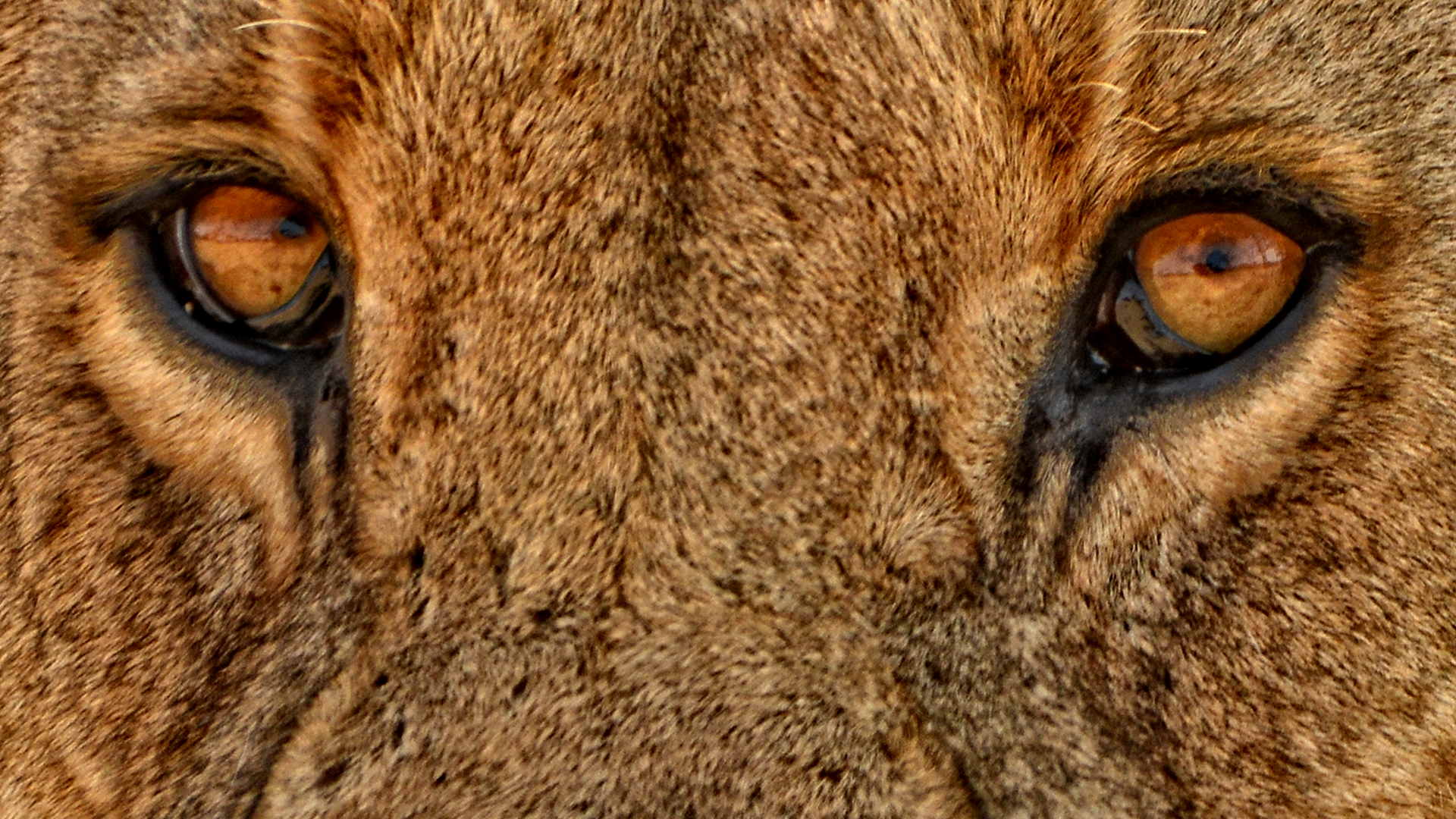
We are in Botswana’s Linyanti Concession. This is a vast and wild region in the north of Botswana. Access is difficult, only 4x4 vehicles are able to negotiate the thick sand and rough roads. Most visitors, like us, arrive by light aircraft at remote airstrips. But it’s well worth the journey. This is an area of stunning floodplains, palm islands and lush grasslands. Away from the water, there’s thick saltbush and huge tracts of mopane woodland. We are staying with African Bush Camps at their Linyanti Bush Camp, in a private game reserve that shares an unfenced border with the north-western reaches of the Chobe National Park. The area is renowned for the abundance of elephants and other wildlife, including huge herds of buffalo, zebra, giraffes and more. Remote and with an incredible sense of space, the camp overlooks the marsh and floodplains, with Namibia in the distance. This is a precious and unexplored wilderness, a place for people who are passionate about raw Africa. With just six luxury tents, Linyanti Bush Camp overlooks the Linyanti Wetlands, a marsh and floodplains that in the dry months becomes the primary water source, attracting large herds of elephants, buffalo and zebra, who are reliant on the river system.

We set out that morning on the trail of the lions and buffalo from the previous evening. Not far from camp, we find the battle scared, exhausted, but very much alive buffalo, sheltering as inconspicuously as possible under some bushes. Of the lions, there is no trace. Heading down to the water, five or six hundred buffalo wade through the shallows, with red-billed oxpeckers and cattle egrets riding on their backs. We surprise a pod of hippos sunbathing, and they tumble down the bank, splashing into the water with general gnashing of teeth at one another. Giraffes, a large group of waterbuck and a pair of black-backed jackals complete the scene. We turn to head back to camp for brunch. Searching the sandy trails for lion footprints, we have no luck. But then, just as we were about the reach camp, out of the corner of his eye, Kenneth catches a glimpse of what looks like lion spoor. Gun in hand he gets down from the vehicle and heads into the undergrowth, while we circled round in the vehicle, now in the hands of Kenneth’s assistant guide, Lucky. Lucky by name and lucky by nature, sure enough, round the corner, Lucky finds the lions. Resting, under a bush and clearly exhausted from the previous night’s shenanigans. One male lies to the side, clearly the loser in the battle for love. He licks his wounds surreptitiously. The victorious male lies with ‘his lady’ by his side, and has several deep, oozing wounds on his face that are being worried at by flies. The lady in question, nonplussed by the attention she had generated, is asleep in the shade. She doesn’t appear terribly interested in either of her suitors, and I get the impression she is going to wander off when the opportunity presents itself. Female lions are only receptive to mating for three or four days, and it looks like her ‘days’ are nearly done. Lions are known to mate about every 20 or 30 minutes during this time, with as many as 50 copulations in a 24 hour period. No wonder everyone involved is looking so listless.
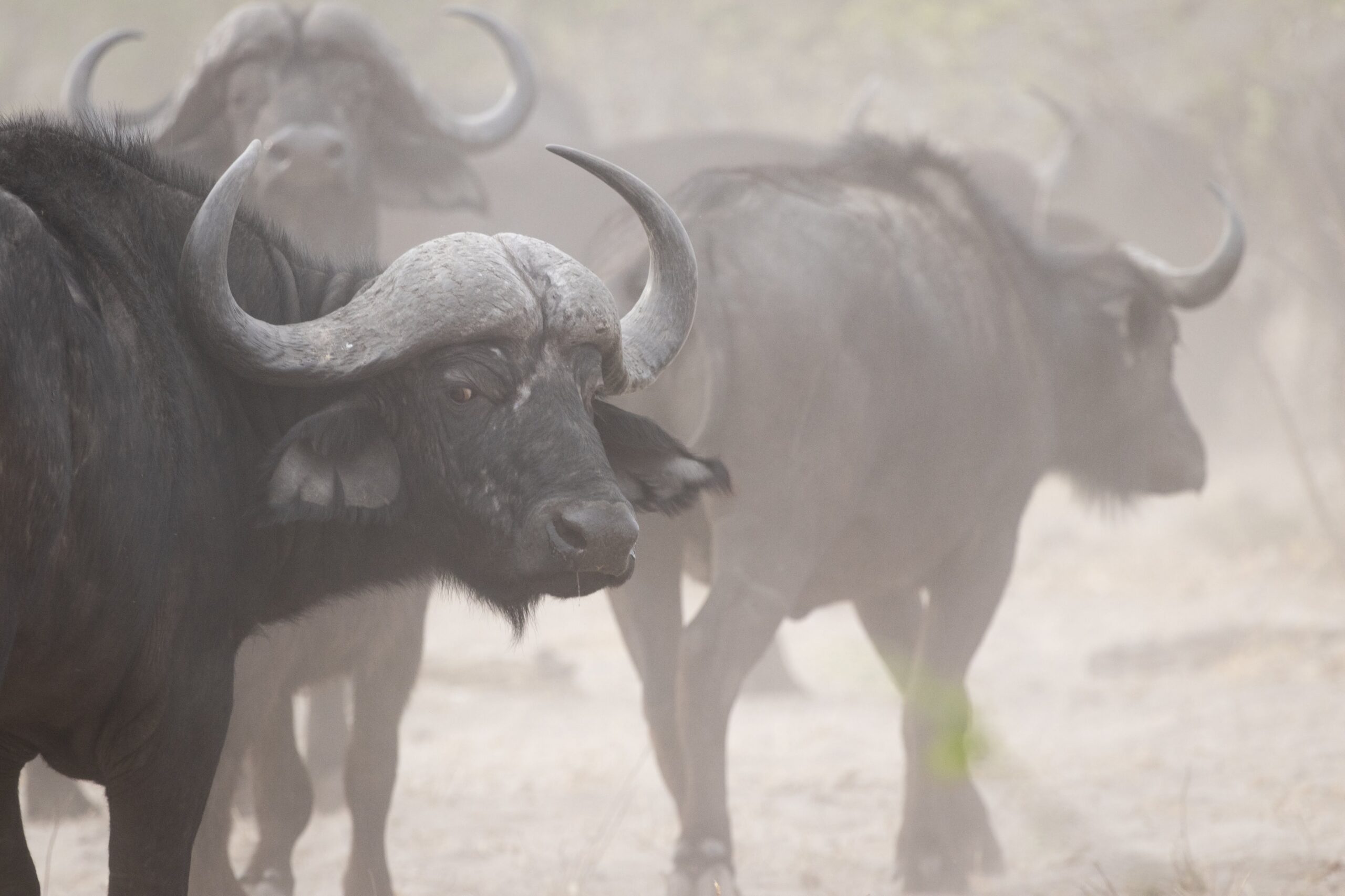
Back in camp, brunch is served accompanied by a cacophony of birdsong. Glossy starlings, bulbuls, fork-tailed drongos and hoopoes make their presence known, loudly. They swoop from tree to tree. One glossy starling taking a particular shine to us, sits on a post next to the table for the duration of our meal, casting me beseeching looks from time to time. I feel certain given time, and a few shared crumbs, we could become firm friends, but it is not to be. Just as brunch is drawing to a close a small family of elephants saunter past the dining room and down to the waterhole. My ‘friend’, the starling, disappointed by my now empty plate, and enticed by the attraction of the elephants, abandons me, moving to a post with a better vantage point of the waterhole.
Later that day the sunset is magical. The channels of water on the floodplains light up like molten lava, as the sun sinks in the sky. Thousands of Burchell’s starlings fly overhead, leaving the mainland to roost in the safety of the reeds on the floodplains. A scops owl trills in a nearby tree and we sit and listen. As it gets dark we find ourselves surrounded on all sides by elephants, moving remarkably silently given their size and the dense, dry vegetation.
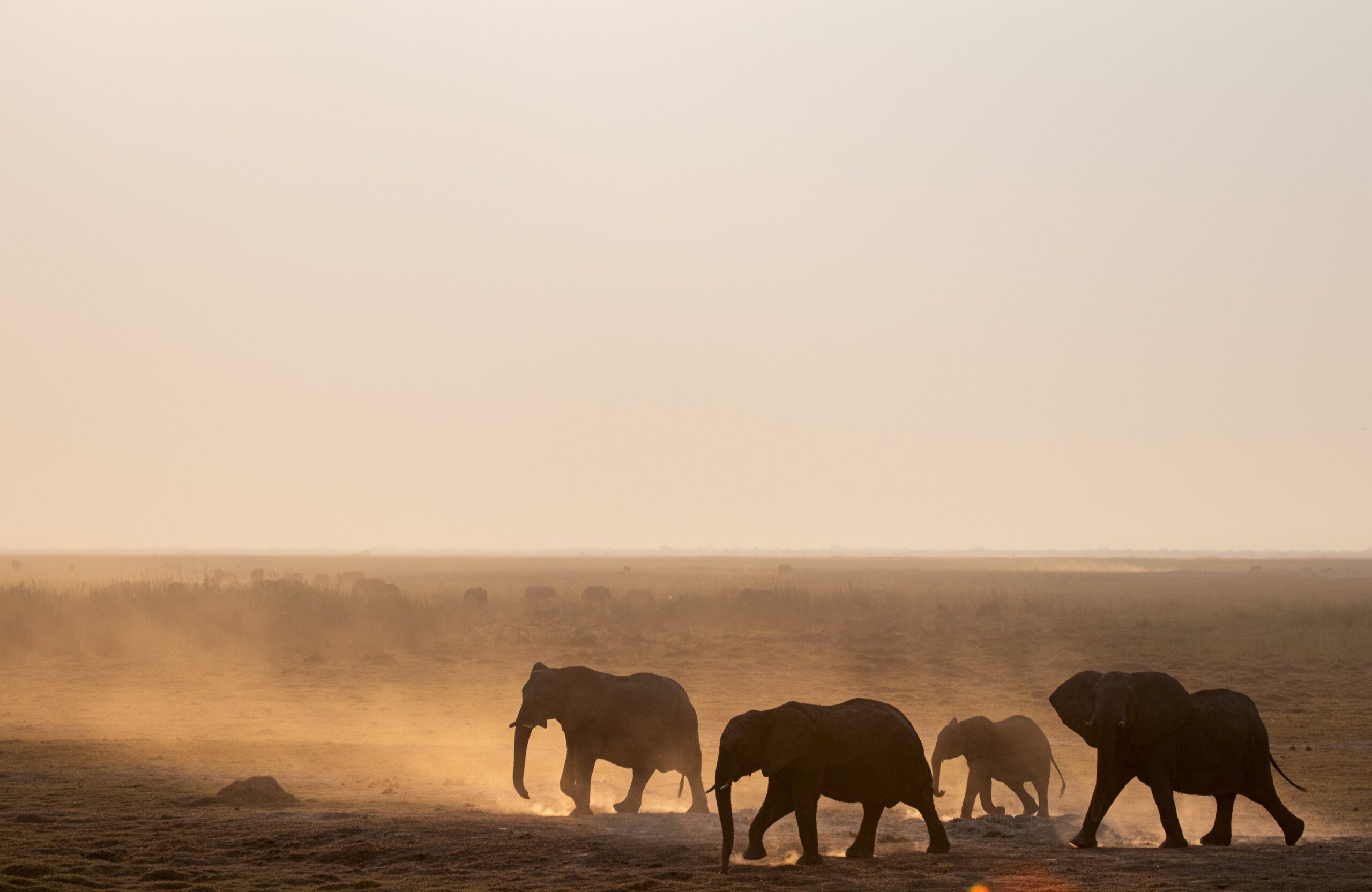
Taking a bath before dinner might be nice, I think. I rapidly change my mind, when I see the bathtub on our verandah is surrounded by elephants. Opting for a shower instead, I feel the ground shake and the air tremble as the elephants, just on the other side of the canvas walls, communicate with one another, using a series of low-frequency rumbles. Dinner itself is accompanied by some vegetarian creatures munching to the left and yet more elephant rumbles to the right. Later we go to sleep with the sound of hyena’s calls ringing in our ears, and in the morning wake to the sound of lions and distant braying zebras.
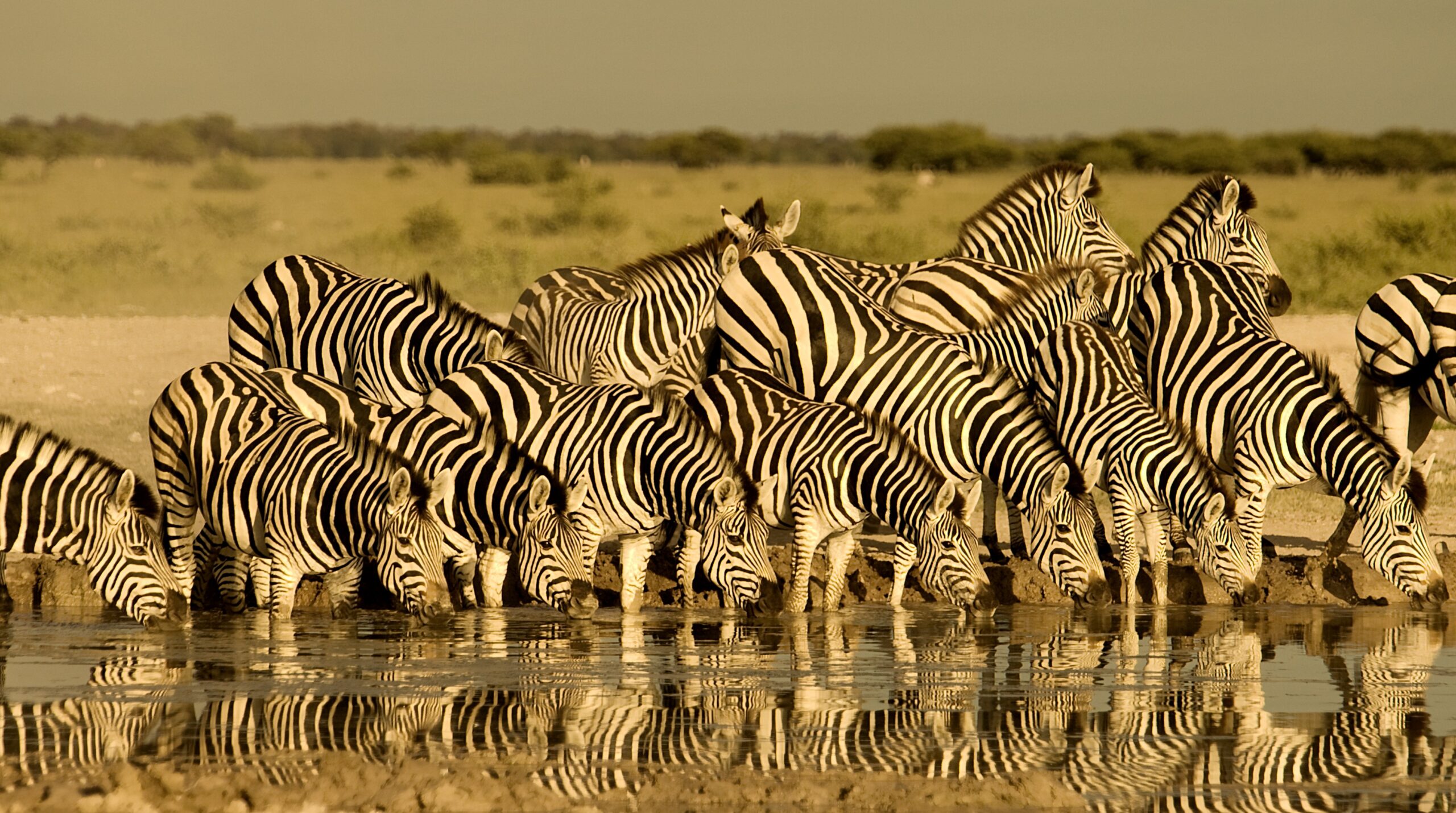
Half an hour’s light aircraft flight, from the Linyanti bush airstrip, but still staying in the North West of Botswana, we move to the Khwai Community Concession. Khwai is a 1,800 square kilometre area, wedged between Moremi and Chobe National Park, comprising the northeast fingers of the Okavango Delta. The area is managed by the Khwai Development Trust, on behalf of the local community. The area used to be a hunting concession but is now managed as a conservation area. With a population of just 400 people of BaBukakhwe or River Bushmen descent, this is an example of how a local community can live in harmony with wildlife and still benefit from it. The local people run ecotourism initiatives, actively conserve the environment and manage the wildlife in the concession. For visitors, this means knowing that the proceeds of their trip directly benefit the local people, which is in turn vital for the survival of any conservation area. Khwai has a varied ecosystem of lagoons, pans, plains and woodlands. There are no fences here to restrict animal movement, and the area has a reputation for magnificent wildlife sightings.
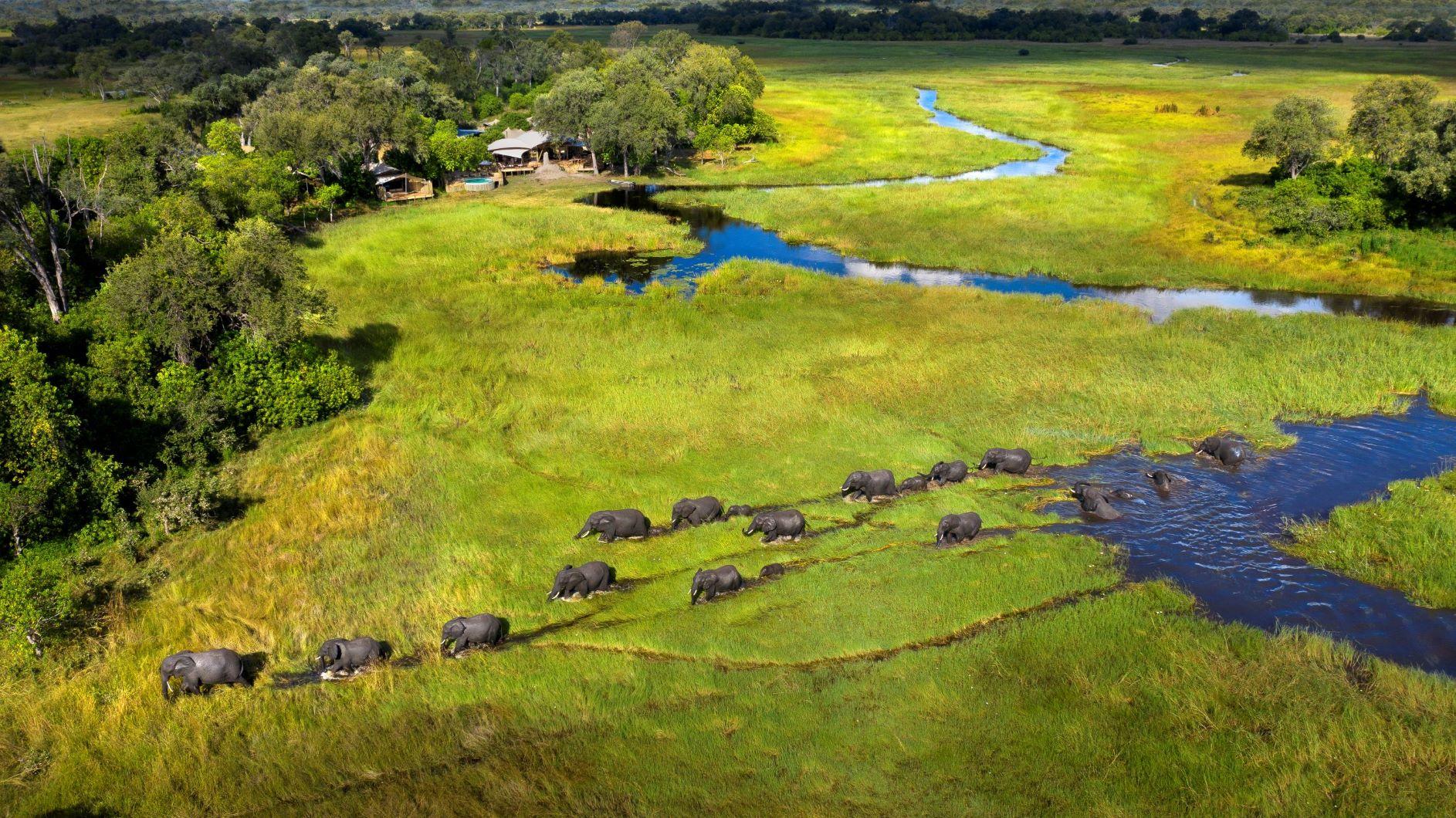
Early morning finds us sitting silently beside a hyena den. At first, it seems as though there’s nothing to see. But as the sun rises a little higher in the sky, and the air grows a little warmer, we spot a couple of moist, black noses poking out of the den’s entrance, testing the air. The noses disappear. A minute later eight baby hyenas of various sizes, and ranging in colour from black to mottled brown, tumble out of the den. There is no sign of any adults, and the two smaller babies stay close to the entrance of the den, slightly nervous and ready to disappear at the first sign of danger. Our guide Joe, and his sidekick Mighty, tell us that the babies range in age from ten weeks to four months, and belonged to three different mothers, all of whom were presumably still out hunting. They are equal parts cute and curious, we spend some hours watching them play and wrestle, laying the groundwork for seniority and dominance in later life. One particularly brave youngster heads over to the vehicle and stands by the door looking up into our eyes. He seems so brave and so confident, we could almost reach out and touch him, but obviously, we don’t! One of the mothers returns to the den, the youngsters all scampered in her direction, licking her mouth, looking for the taste of blood. She drops a piece of bone and a few scraps of meat and they get busy eating.
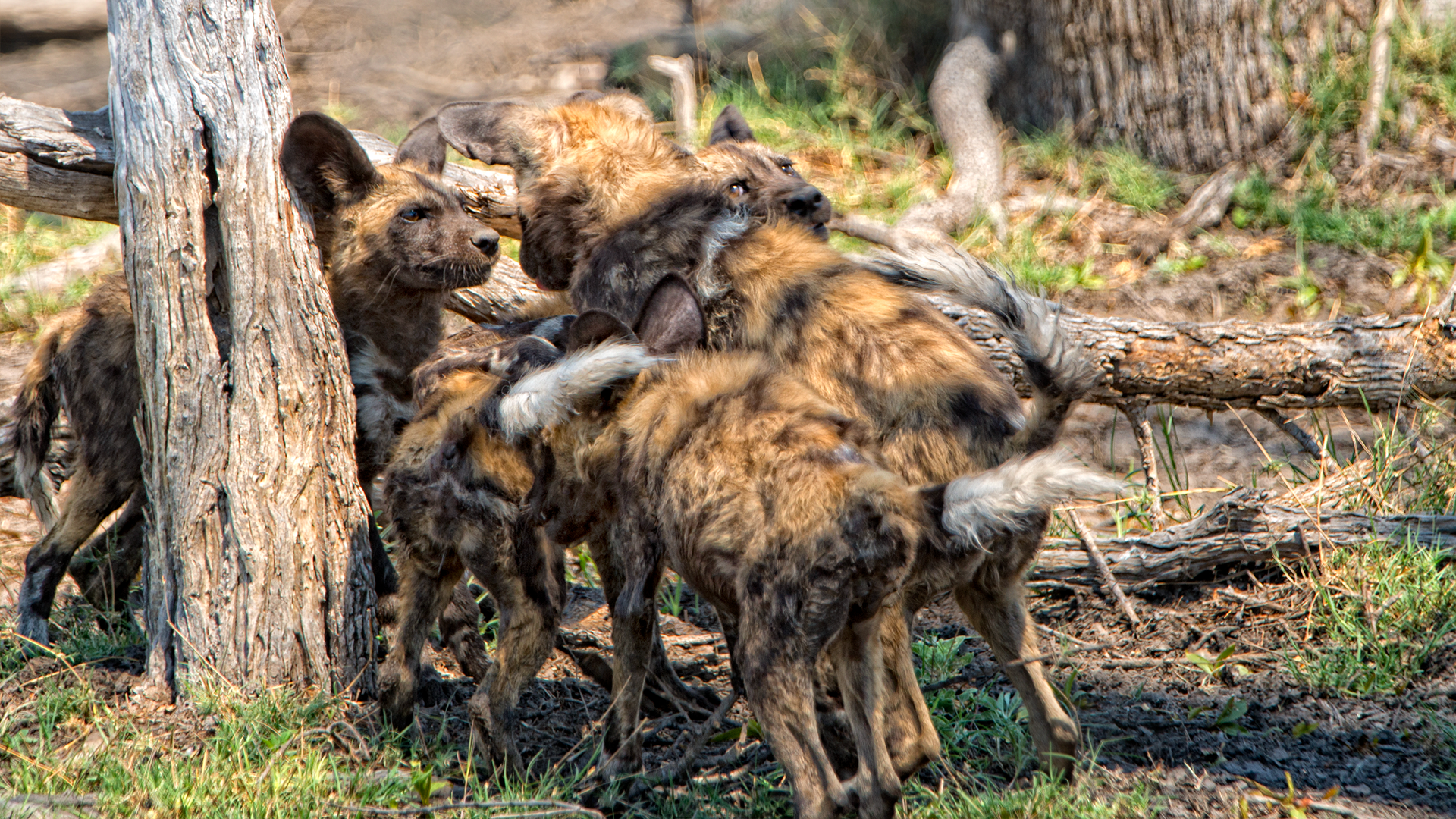
Out in the reserve later in the day, we find a waterhole full of fish, trapped by the dry season receding water levels. With no way to escape they are being preyed upon by hundreds of pelicans, storks, spoonbills, egrets, cormorants and darters; a living net of beaks making its way down the length of the waterhole, scooping up fish as it goes, devouring everything in its path. Wave after wave of birds joins the hunt. A flurry of white, pink and black feathers, yellow bills, black bills, red legs, yellow legs, short legs, long lanky legs; no fish is safe. As we sit and watch, a wild dog appears from the bushes on the other side of the waterhole. Unperturbed by the birds, it waits until they pass and then splashes through the water towards us. Making a last-minute detour around the vehicle, she walks with purpose, in a straight line, across the landscape, until eventually disappearing from sight.
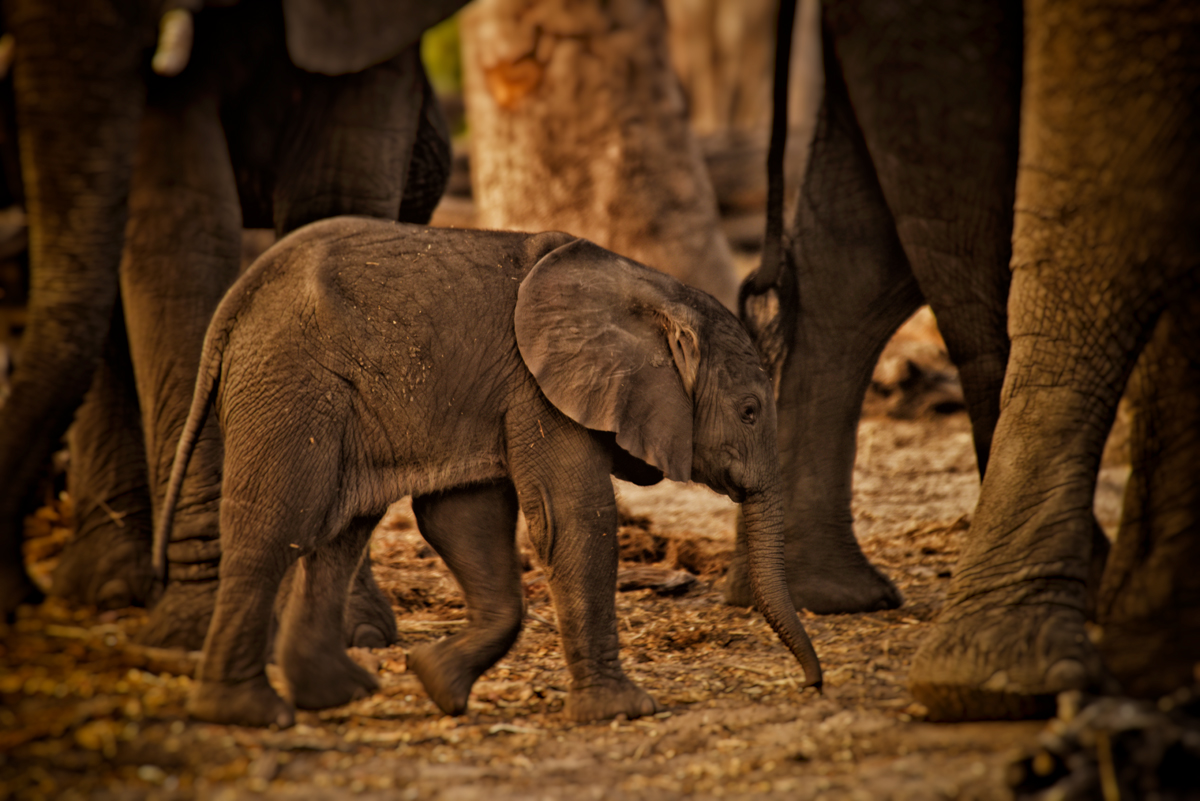
Heading in the direction the wild dog has come from, we come to a wild dog den. It is quiet when we arrive. But within minutes a female arrives, calling out with a high-pitched chirrupy voice. Five babies emerge from the den and run towards her in great excitement. She regurgitates some food and they gobble it down, then latch on to her teats and begin to suckle. We watch while she patiently waits until they’ve had their fill, before she runs around the perimeter of the den’s territory, sniffing and marking her scent, then lying down to rest in the sand. With an adult present, the four-month-old babies clearly feel a little more confident, and we are treated to a wrestling match and some games before they eventually tire and disappear back into the den. It is getting dark by now and time to head back for dinner. Seventeen giraffes of various ages and sizes amble along the dusty road beside us, almost as if they are an entourage escorting us home.

We spend quite a bit of our time in camp mesmerised by an endearing young hippo who has taken up daytime residence there. The now four months old male hippo has been forced out of the pod by an aggressive and dominant male. With his mother unable to protect him he’s cleverly taken refuge by the camp, spending hours each day sunbathing at the bottom of the verandah steps, even using the rough edge of the bottom step and the prickly floor mat as a convenient scratching post. When darkness falls he returns to his mother, who has been keeping a distant but watchful eye on him, and spends the night with her in the channels and long reeds nearby. Like with the hyena young and wild dog pups, it is tempting to befriend the young hippo, but we know we have to keep our distance and not interfere… that doesn’t stop us from spending all our mealtimes watching him though.
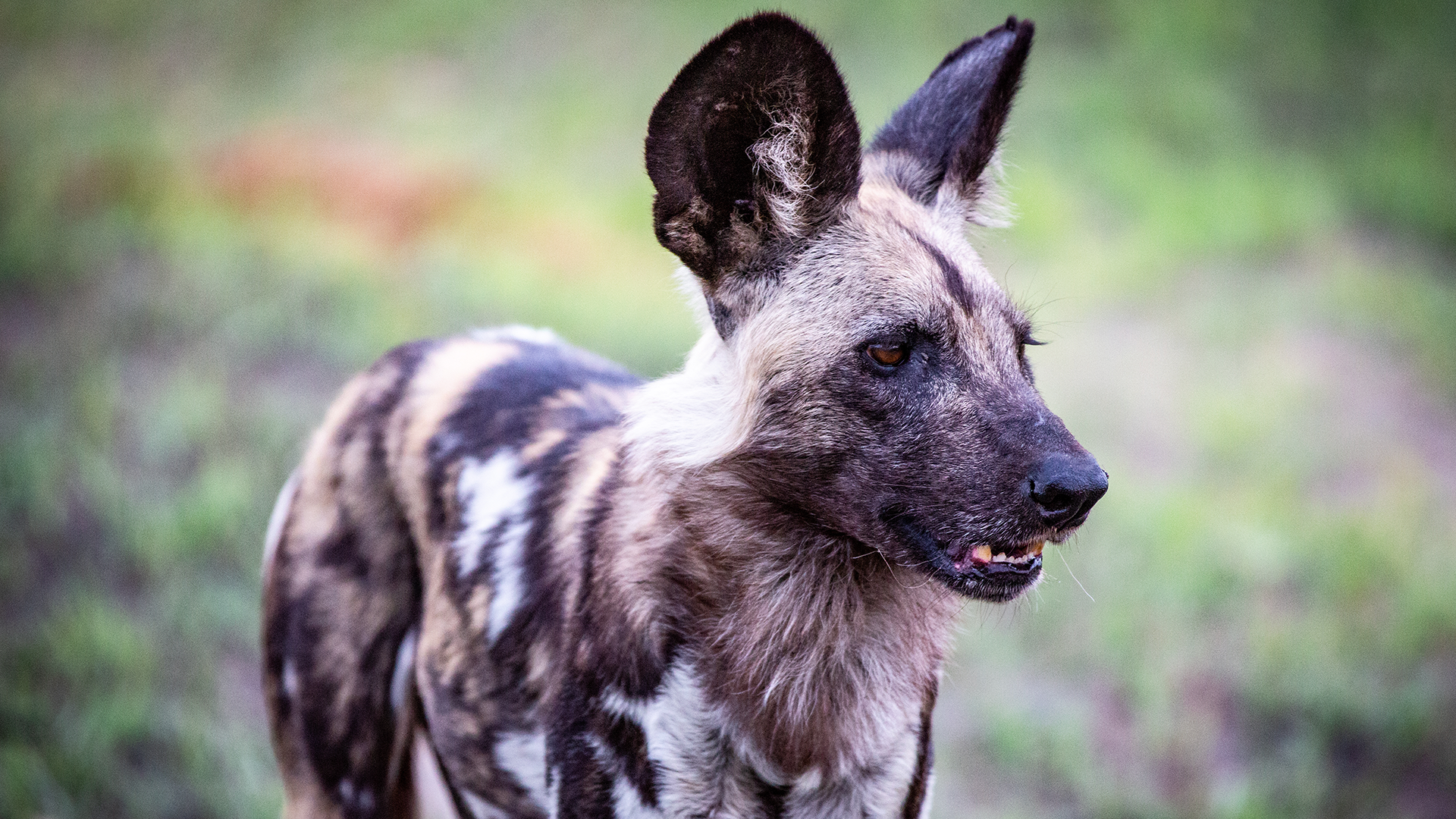
A tranquil afternoon is spent paddling through the channels in a mokoro (canoe), passing vibrant malachite kingfishers and dancing dragonflies, hippo eyeing us with suspicion. Sundowners on the bank, at the end of the day, is accompanied by six or seven huge bull elephants who wade through the channel in front of us, as we drink our deliciously chilled gin and tonics.

The grand finale to our time in northern Botswana is an ‘open doors’ helicopter ride over some of the most remote and untouched areas of the Okavango Delta. Taking off from the camp’s private helipad we fly across the Khwai River and over Moremi Game Reserve. Flying at the same height as a couple of Bateleur Eagles, we get a new perspective on these magnificent birds and a ‘bird’s eye’ view of everything below. Elephants, giraffes, waterbuck, red lechwe and herds of buffalo, all look so small from above. The water is so clear we can see hippo trails on the bottoms of the channels and waterholes. Ducking underwater as soon as they hear our approach, the hippos think they are now invisible, but we can see them clearly as they walk along the sandy bottom.
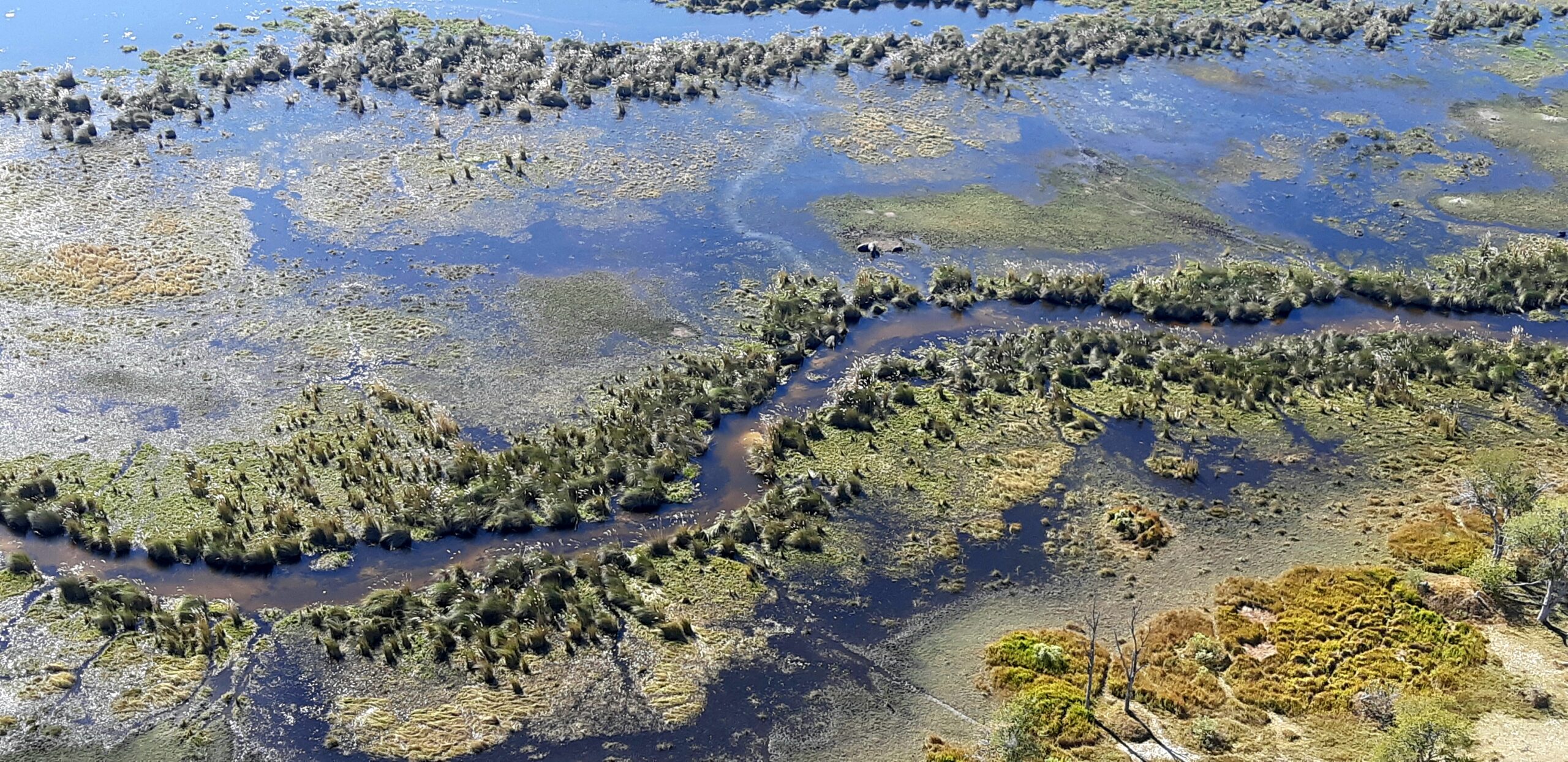
There are not many places I’ve been to that are as special or as beautiful as northern Botswana, the landscapes are wonderful, the wildlife sightings exceptional, the guides knowledgeable, the people friendly. A fantastic place and one I hope to return to time and time again.
African Bush Camps https://africanbushcamps.com/destinations/botswana/
Cover photo: Young hyena venture out from the den













